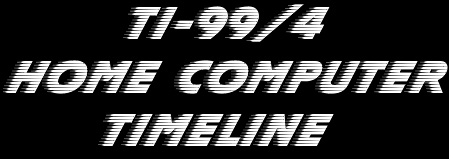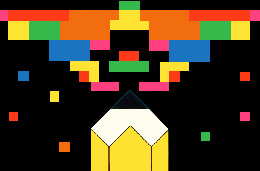| Texas
Instruments Home Computer |
 |


 |
1977: In January Texas Instruments begins designing the TI-99/4 computer in Dallas, Texas. By May the 99/4 group is moved to Lubbock where it would remain until the end of the TI-99/4A's lifetime in 1983/1984. 1978: Texas Instruments begins programming the Early Learning Fun, Beginning Grammar, Physical Fitness, and Home Financial Decisions cartridges for the TI-99/4 computer. Also, Microsoft is contracted to program TI Basic for the 99/4, which will come built into the system. Sometime during the year TI gives 200 selected workers prototypes of the up-and-coming TI-99/4 to take home and play with for 6 months. These units use TMS 9900 chips emulating the TMS 9985, which is the chip to be used in the final production console (the TMS 9985 is a new and cheaper to produce chip than the 9900). FEBRUARY 1979: Texas Instruments sends their RF Modulator device to the FCC for approval so that the 99/4 can be used with a standard TV, however, the FCC rejects the modulator since TI did not also send the entire TI-99/4 system. This in turn forces TI to bundle the computer with a 13" monitor, jacking up the price. Rumors are flying about Texas Instruments' impending entry into the personal computing market. The unit will reportedly use the TMS 9900 processor (the TMS 9985 turned out to be a complete failure, forcing TI to go with the more expensive 9900 chip) with 40K of read only memory circuits, will generate 20 lines of 40 characters on a standard television, will have provisions for accommodating video disk players and video tape recorders, and will have sophisticated sound production. Sources predict a mid-1979 unveiling. JUNE 1979: Texas Instruments introduces the TI-99/4 Home Computer at the June CES show in Chicago. At the show TI had wireless infrared keyboard and joystick peripherals ready to demonstrate to the public, however the presenters of the unit were told not to bring them out since the price of the 99/4 was now much higher than originally anticipated (first the TMS 9985 having to be replaced with the gold lead ceramic packaged TMS 9900 and then the rejection from the FCC on the modulator). Even though the wireless units were withheld from public viewing, the 99/4 that was shown still had the Infrared slot on the top of the casing. AUGUST 1979: The first TI-99/4 review is printed in Interface Age magazine and gives the system a good grade. Obviously the author had access to a prototype unit, as the computer was not yet out on the market at the time. Also reported in the article is the fact that Milton Bradley is coming out with a cartridge series later in the year for the computer called Gamevision. Milton Bradley actually had a hand in developing the TI-99/4 computer, which is one of the reasons for the close friendship throughout the years. OCTOBER 1979: Texas Instruments starts shipping the TI-99/4 computer system, with a suggested retail price of $1150 that includes the 13" color monitor (which is actually a re-branded Zenith TV without a tuner). The initial 11 cartridges offered for the system are Diagnostic, Demonstration, Early Learning Fun, Beginning Grammar, Number Magic, Video Graphs, Home Financial Decisions, Household Budget Management, Video Chess, Football, and Physical Fitness. These cartridges would make it to market at various months before the close of the year. NOVEMBER 1979: It is reported that TI is unsatisfied with the TI-99/4 system due to the high initial offering price. Magazines report that the 99/4 is only expected to be an interim project that will later be replaced with a cheaper system, under $500, sometime in 1980. The later system would use the TMS 9985 after further development is done on the chip and an RF modulator with approval from the FCC. This system is assumed to be the TI-99/3 that TI had on the drawing boards since the beginning of the year. DECEMBER 1979: Milton Bradley releases the Gamevision cartridges Connect Four, Hangman, Yahtzee, and Zero Zap. They are manufactured and sold by Milton Bradley and come in attractive blue boxes. This would mark the first 3rd party to actually release games for the TI-99/4 system. Interestingly, Milton Bradley is only planning on producing these cartridges for a short time period (about 1 year) before passing production over to TI. This was probably written in a contract between Milton Bradley and TI since TI had a habit of making everyone sell them the rights to their games for production. Image Computer Products announces the TI Six Pack which consists of 6 cassette based games (Tournament Brick-Bat, Wall Street Challenge, Wildcatting, Strategy Pack 1, Mind Master, and Skill Builder 1) all programmed in TI Basic. This is again another milestone in the TI-99/4's lifetime, since it is the first 3rd party to actually produce games for the system that did not have a close connection to TI (Milton Bradley had hands in developing the 99/4, so it's no surprise they came on early with games for the system). JANUARY 1980: TI gets a waiver from the FCC which allows them to sell an RF modulator for the TI-99/4. This in turn means that users will not be forced to buy a TI monitor along with their console anymore, bringing the 99/4's price down to $599. This waiver from the FCC might have been a big reason why TI never introduced the 99/3, since the price of the 99/4 was now around the price that the cheaper 99/3 would have sold at. FEBRUARY 1980: TI releases the Disk Controller and Disk Drive stand-alone units for the 99/4. They retail for $299.95 and $499.95 respectively. This gives users the opportunity to finally use something other than cassette tapes as a storage medium. JUNE 1980: According to the June issue of Fortune magazine, it is determined by an independent market research firm that TI would sell only 25,000 total units by the end of the year. This number covers the total number of units expected to be sold from October 1979-December 1980. FEBRUARY 1981: TI discontinues production of the 13" Color Monitor made by Zenith and replaces it with a smaller 10" monitor from Panasonic. This new monitor sells for $374.95, while the Zenith-made monitor sold for $450. JUNE 1981: The new and improved TI-99/4A is shown at the June CES show at a price of $525, which includes an improved keyboard and better graphics (TMS 9918A chip). AUGUST 1981: The TI-99/4A finally hits the streets and replaces the old TI-99/4 model. The new TI-99/4A would in turn go on to sell around 3 million consoles worldwide. |
